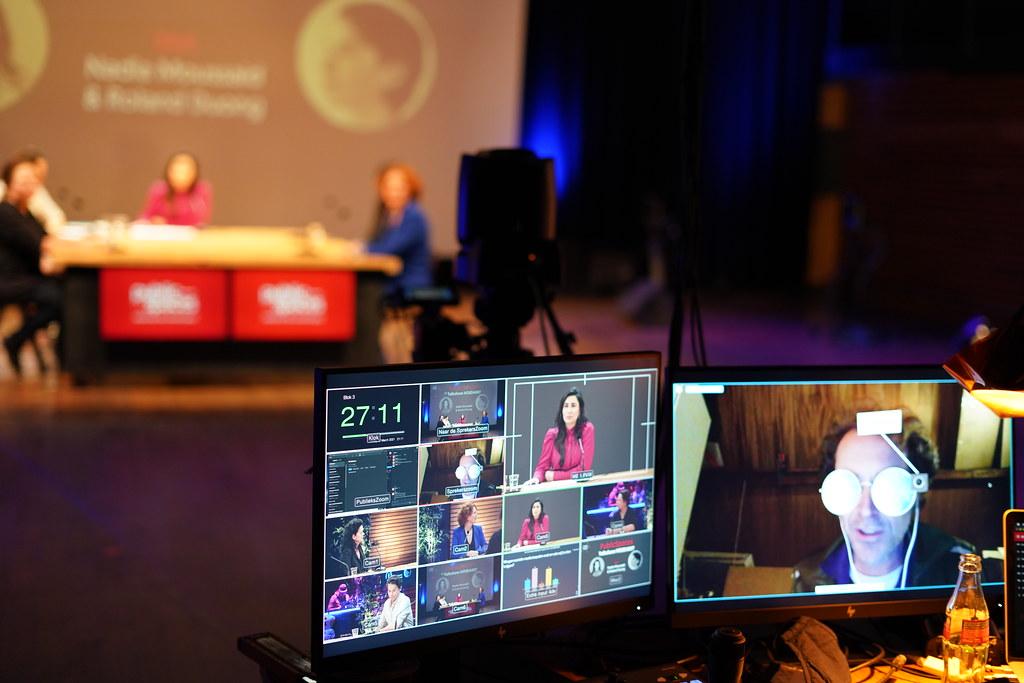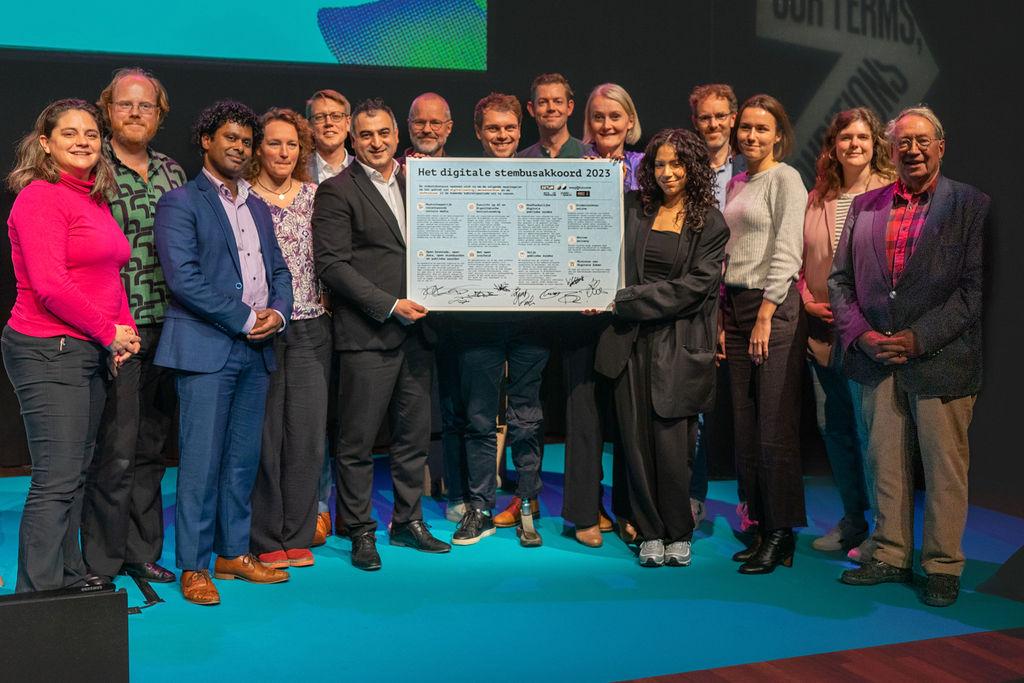By Marit Hoefsloot
When talking about public spaces, we distinguish the physical public space from the digital public space. For example, during the opening session of the Public Spaces conference on 12 March, a clip was shown that described why digital public spaces are important (watch the clip at 5:25). In the current system of public platforms on the internet, these platforms are under the control of commercial companies that see citizens as objects, rather than subjects. The clip continues to tell us that the commercial nature of the digital spaces ‘is like having your passport sold whenever you visit a public library. [Or] like being allowed in a public debate centre, only if you have a specific political view.’
But what struck me in this clip and the discussions surrounding it, was that these physical public spaces – the library and the debate centre – were portrayed as intrinsically non-digital. They are imagined as technology-free safe spaces where people can interact freely and anonymously, without getting tracked and surveyed. However, physical public spaces are increasingly being digitised through technologies such as surveillance cameras and facial recognition. Essentially, cameras equipped with facial recognition technology are able to recognize and identify people (for more info, read the Do Worry Be Happy blog). The algorithms that power these technologies can, for example, predict someone’s gender, ethnicity, and age.
Physical public spaces are increasingly being digitised through technologies such as surveillance cameras and facial recognition.
In the not too far future, we can even expect this technology to be used for targeted advertising in the public sphere (Santarcangelo et al., 2015). Imagine waiting at a bus stop while a facial recognition system looks at your face to predict your gender. This prediction is then used to inform which advertisement you’ll see on the digital sign that makes up the side of the bus stop. If you are recognised as a woman, you will see an advertisement for a new perfume. But if you are seen as a man, you will get a picture of a new sports car. (It is important to note that this distinction between men and women and the corresponding stereotypes as used by Santarcangelo et al. are binary and limited representation of gender, which I do not want to perpetuate.)
Surveillance cameras and facial recognition technologies are not the only ways in which physical public spaces are being digitised. It is also important to think about the technologies we bring into the physical public space ourselves. For example, smartphones and newer cars are all equipped with sensors that track and share data with their developers, or even their governments. In the Netherlands, several municipalities make use of the smart retailing solutions offered by Bureau RMC. These solutions are essentially sensors that count the number of devices in a certain area based on their WiFi signals. Your device does not need to connect to a public WiFi network to be counted, but merely needs to be looking for possible WiFi connections. This information is then gathered and displayed in maps to visualize the crowd-density in real-time.
The municipality of Enschede hung up signs to indicate which areas are subject to their WiFi counting systems. These rather small and unremarkable signs also state that there are opt-out options available on the municipality’s website. However, I was personally – as a reasonably digital literate person – unable to find and make use of this opt-out option. While it might seem as if the municipality made the effort to inform their citizens and give them the power over their data, in reality, many citizens are unaware that their devices are being counted and unable to do something about it.
This is even more troubling in Amsterdam, where the municipality has decided to create an online map with the locations of their crowd sensors and WiFi counting systems (Sensoren Crowd Monitoring Systeem Amsterdam). Without street signs, most citizens and tourists would never know their devices are being counted (also read this Volkskrant article).
'Physical public spaces are much more digital than we might think.'
It is not news that the correctness of facial recognition is limited (see the Coded Bias documentary). Nevertheless, the prevalence and reach of such technologies are still misunderstood and underestimated. While mobile phones and cars are visible and privately owned, many people have a limited understanding on how their data are collected and used. Moreover, when you use your iPhone to take pictures in a park and post them on Facebook, you are sharing your physical public space with the digital corporate world. This way, the private digital spaces enter and essentially privatise the physical public space. In short, physical public spaces are much more digital than we might think.
Even in discussions with experts on public space and digitalisation, as was the case at the Public Spaces conference, there are still assumptions present in which public spaces are seen as safe from invasive digital technologies. While digital public spaces are portrayed as intrinsically constituted by surveillance and tracking technologies, physical public spaces are idealised as free from these technologies. However, this is a misconception. Physical public spaces are always subject to state and corporate surveillance and are also often filled with technologies for tracking, surveillance and identification.
The use of digital technologies such as facial recognition and WiFi tracking should play a more central role in conversations regarding public spaces, either physical or virtual. Because, there is no such thing as a non-digital public space anymore. We need to protect our digital public spaces, both the physical and the non-physical. The more we let corporations and governments privatise our public spaces, the less public they will become.
Of course, we can turn our devices and their WiFi signals off, or even create ways to protect our faces from being recognized. Last year, Waag organised an event based on CV Dazzle, where we made face masks that protect your identity against facial recognition. However, this approach reinforces the idea that we must accept that technologies such as WiFi counting and facial recognition on the streets are a given.
'We must create ways in which digital technologies take public values into consideration.'
Instead, we must create ways in which digital technologies take public values into consideration. Waag is working on a model and design methodology to make sure the different layers of hardware and software are developed from public values (read more on the Public Stack). This way, the internet and everything that comes with it can be trusted by citizens to protect their digital rights. However, current use cases are mainly focused on technologies such as mobile phones and online platforms. As physical public spaces are increasingly shaped by digital technologies, the public stack models must be extended to include these spaces and technologies, too.
This could take different forms, but one example is extending digital privacy protocols and codes of conduct into the physical public space. For instance, Enschede’s WiFi counting systems do not track passers-by; the system does not follow the individuals from one place to the next. According to their website, RMC anonymizes their data twice to comply with the General Data Protection Regulation (GDPR). This is a relatively new system, as RMC's previous approach did not comply to the GDPR. In fact, on the 29th of April 2021, the Municipality of Enschede received a 600.000 euro fine for their WiFi tracking system. Nevertheless, the current system is a good example of privacy-by-design, as it is built in such a way that the registered locations cannot be traced back to a single user. While this is one approach to ensure the basic privacy of the citizens on the data storage level, we need such protocols for every layer of hardware and software.
This is where the Public Stack comes in. As a communication model, it provides the tools to open the discussion surrounding digital technologies in physical public spaces and to make digitised physical public spaces more open and democratic. With the Public Stack model in hand, the City of Enschede and Bureau RMC could, for example, investigate the different hardware and software layers of the WiFi tracking technologies and evaluate whether public values such as openness, fairness, and inclusivity are being upheld throughout all aspects of the technology. A proper solution would be to go further than merely anonymising the data, and would incorporate privacy-by-design at all layers of the stack model.


